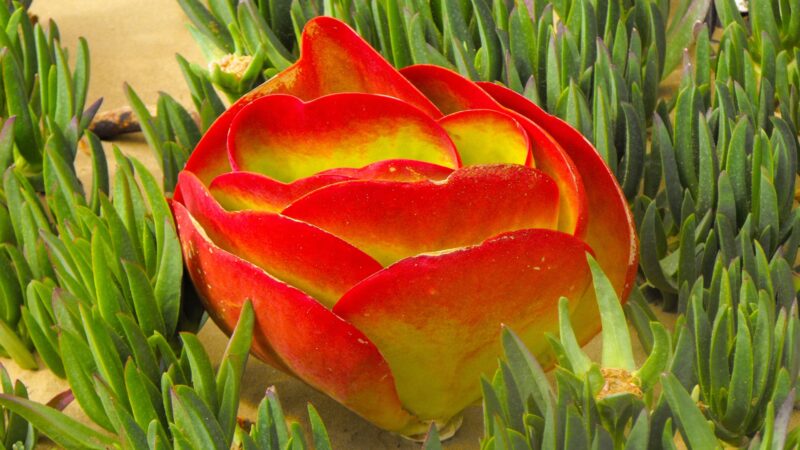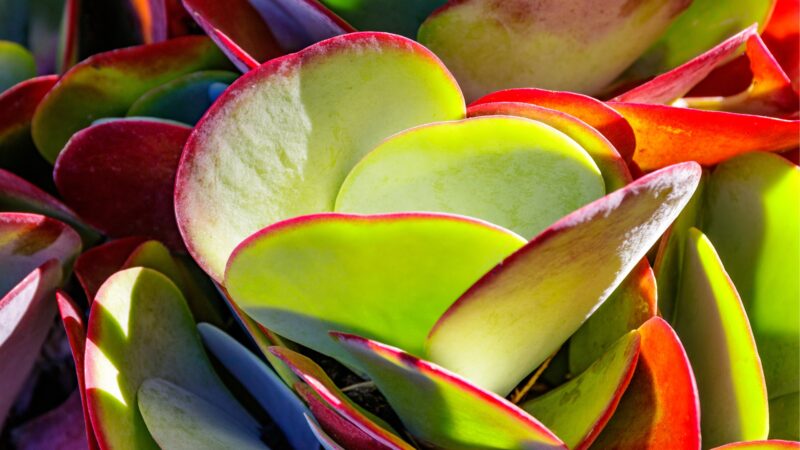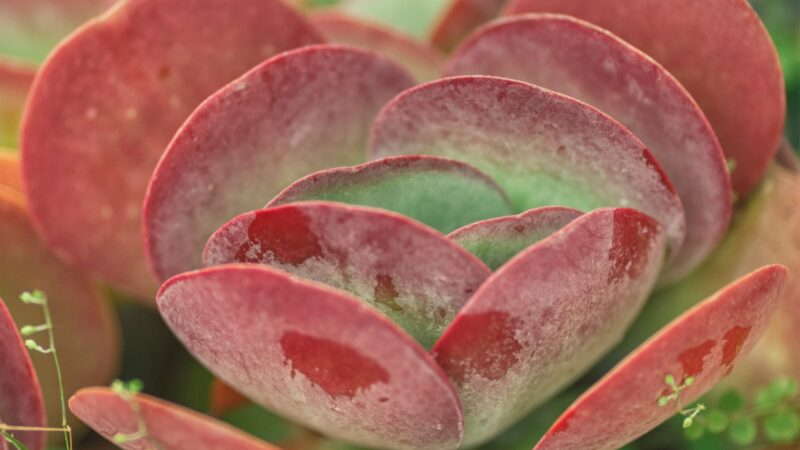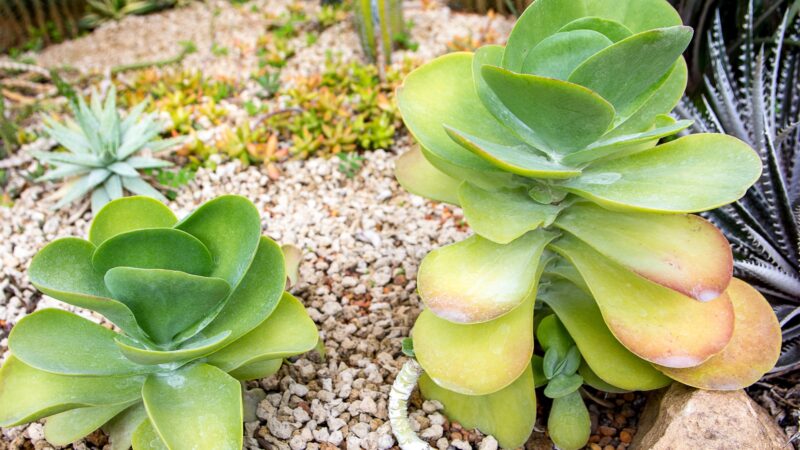A unique succulent due to its chalky, bluish to grayish-green, paddle-shaped leaves that are stacked together like pancakes, the Paddle Plant is an easy-to-grow, low-maintenance plant for gardening beginners and experts alike.
To take good care of a paddle plant, plant it in light, well-draining soil in a 4-inch or 6-inch porous or semi-porous container, then place it in a location where it can receive full sun for 6 hours daily. It prefers temperatures of 50°F to 75°F and watering when the soil is dry enough.
This article will provide you with everything you need to know about taking care of a paddle plant, when and where to plant it, how to propagate it, common problems, and other interesting information. Read further for more!
What Is a Paddle Plant?

Paddle Plant is a drought-tolerant succulent named after its paddle-shaped leaves. It usually blooms in the late winter to early spring seasons if protected against frost and given sufficient light.
This plant is usually used in mass plantings or as an accent plant in rock gardens, borders, dish gardens, and hanging baskets. Like other succulents, it requires little water.
- Scientific Name and Common Names: Kalanchoe Thyrsiflora; Flapjack, Desert Cabbage, Dog Tongue
- Appearance: Has large, fleshy, paddle-shaped, slightly cupped grayish-green leaves that are covered with a flour-like wax coating, are stacked like pancakes, and with edges that turn red or blushing pink. It produces aromatic yellow flowers borne on tall flower stalks.
- Origin: South Africa
- Indoor or Outdoor plant: Outdoor (warmer climates), Indoor (cooler climates)
How Big Do Paddle Plants Get?
Paddle plants commonly grow to a height of 24 to 30 inches, with their basal rosette measuring up to 18 inches and lengthy flower spikes of up to 30 inches, but can only reach up to 10 inches when planted in containers.
Does a Paddle Plant Grow Quickly?

They grow slowly, especially when planted indoors, and typically take 3 to 4 years to reach full maturity when their flowers finally bloom. Paddle plants are monocarpic, which means that once they flower, the blooming rosette will die.
How Long Does the Paddle Plant Live?
If properly taken care of, the paddle plant can last up to 7 years. However, you cannot get the plant to rebloom again once the rosette in bloom dies.
Paddle Plant: Kalanchoe Luciae vs. Kalanchoe Thyrsiflora
| Characteristics | Kalanchoe luciae | Kalanchoe Thyrsiflora |
| Leaves | Obovate in shape with blunt, rounded tips and a white to gray powdery bloom | Smaller and slightly cupped in shape with a flour-like wax coating |
| Leaf Margins | Develops a more pronounced pink or red color | Rarely shows a pink or red coloration |
| Flowers | White to pale yellow color and are usually not scented | Bright yellow color and are heavily fragrant |
When to Plant a Paddle Plant?
Plant during the spring or summer seasons so that it can receive as much sun as it needs.
Can Paddle Plants Survive Winter?

Paddle plants can survive winter, as long as they are protected from the dangers of frost. When planted outdoors, they must be moved indoors to overwinter in a sunny window.
How to Take Care of a Paddle Plant?
Lighting
Paddle plants thrive under the full sun, but they can tolerate a little bit of shade on a particularly hot day or in the summer. However, lack of sunlight can cause the plant to wilt, grow spindly, and/or not develop pink or red leaf margins.
When planted indoors, allow them to sit on a bright, sunny windowsill where they can receive at least 6 hours of direct sunlight every day.
Water
Apply water when the soil is dry enough and allow the soil to slightly dry between waterings but avoid overwatering as the plant can get damaged.
Watering is usually done during the spring and summer seasons when the plants are actively growing. Reduce the amount of water during the winter season to avoid the risk of root rot.
Temperature and Humidity
These plants prefer day temperatures of 50°F to 70°F and night temperatures of 45°F to 65°F. Temperatures exceeding 75°F can delay or reduce blooming.
Since paddle plants are succulents, which means they have fleshy leaves that are filled with water, they can tolerate relatively high humidity and moisture stress.
Soil
A light, well-aerated, well-draining soil is what the paddle plant thrives in. There are also commercially available cactus and succulent soil mixes that they can be planted in.
You can also try creating your mix by using a 1:1 ratio of coarse sand and regular potting soil or a 2:3 ratio of perlite and peat moss.
Pot size
Pot size depends on the diameter of your plant. Usually, paddle plants are sold in 4-inch and 6-inch containers, but they can be placed in pots as small as 2 inches.
Fertilizer
Dilute a houseplant fertilizer to half its strength or recommended rate, then apply every 2 to 3 weeks during the summer or apply only during warmer months. Do not fertilize in the winter until they resume growing in the spring.
Potting and Repotting
Select a porous or semi-porous container (clay, terracotta, or unglazed ceramic) since it is best used for plants that do not require that much water, such as paddle plants.
Make sure there are drainage holes at the bottom of the pot to prevent root rot, decay, and plant diseases. If there are no drainage holes, you can place coarse gravel at the bottom of the pot.
Repot once the roots of the plant grow outwards or if you see that the plant is way too big for its container. Choose a container that is half an inch bigger than the diameter of your plant. For example, if your paddle plant is 6 inches wide in diameter, repot in a 6.5-inch pot.
How to Propagate a Paddle Plant?
Using Offsets
Step 1: Paddle plants usually produce offsets after blooming and are found on the lower part of the flower stalk or at its base.
Step 2: Remove offsets that have already developed roots manually by gently twisting or using a sharp clipper if they are stubborn. Avoid damaging these roots. If no roots have formed or they are damaged, allow them to callus first or form a new mass of tissues.
Step 3: Place into a soil mix a 1:1 ratio of coarse sand and regular potting soil or a 2:3 ratio of perlite and peat moss.
Step 4: Spray water on the offsets directly. Do so gently and sparingly until a strong, robust root system has been established, which usually takes 3 to 4 weeks. Avoid soaking the soil.
Using Leaf Cuttings
Step 1: Choose a healthy, disease-free leaf, then pull it off from the plant gently by using a sharp, sterilized cutting tool. You can also use leaves that have dropped from the plant as long as they are plump and healthy.
Step 2: Let the end of the leaf dry for 1 to 3 days and avoid watering. This allows the wounded edge to seal properly and keep unwanted microorganisms out during the entire rooting process.
Step 3: Once the leaf ends dry, place them directly on top of a dry soil mix. Do not attempt to bury them in the soil. You can also create your rooting medium using a 1:1 combination of fine pumice or grit and compost.
Step 4: Spray the leaves with water sparingly every 1 to 2 days for 4 to 6 weeks. Avoid soaking the soil.
Step 5: Roots will develop after a few weeks found at the leaf ends. That is also where tiny baby plants emerge.
Step 6: Once small plants have emerged, separate them, and place them in distinct containers. Again, use a well-draining soil mix, then water once a week.
Using Stem Cuttings
Step 1: Select a 3- to 4-inch cutting from the mother plant using a sharp, sterilized cutting tool. Remove any lower foliage but leave just a few leaves on the top of the cutting.
Step 2: Allow the stem cutting to callus or grow masses of new tissues. Let it sit on a countertop at room temperature for 4 to 7 days.
Step 3: Treat the cutting using a rooting hormone, then tap any excess away before inserting one-third to one-half of its length into a sterile, well-draining rooting medium.
Step 4: Spray the cuttings, then cover the entire container using plastic. Place the plant in a warm, sunny location.
How to Prune a Paddle Plant?
Regular pruning during both its dormant and growing seasons can help open its stems to better air circulation. Use a sharp, sterilized cutting tool such as a knife, shears, or pruners to cut big or lengthy stems back to their soil line.
How to Treat Brown Spots in a Paddle Plant?

It is usually caused by sun damage. Although paddle plants enjoy a lot of sunlight, make sure it only gets about 6 to 8 hours of them daily. When moving plants into a brighter location or a location with direct sunlight, make sure to transition them first gradually.
Common Problems With Paddle Plant
| Cause | Symptoms | Solution |
| Overwatering | Yellowing leaves, leaf drops, soft and mushy stems, and leaves. | Stop watering immediately and let the plant heal. Once it is healthy enough to be watered again, allow the soil to thoroughly dry out between waterings. |
| Under watering | Yellowing, shriveling, browning, and dropping off of leaves as well as mottled and wrinkled leaves and stems, and root death. | The plant may not recover well even if you water it again so it is better to prevent this from happening by making sure to water the plant when its soil is dry to the touch. |
| Insufficient light | Tall, lanky, and spindly growth with pale-colored leaves and absence of red or pinkish leaf margins (although this is not usually a cause for concern). | Move the plant to a location where it can receive more light. It should be receiving at least 6 hours of daily sunlight. You can also use supplemental lighting such as fluorescent or LED lights. |
| Sun damage | Brown or tan-colored patches or spots can form on the stems and leaves as well as leaf drops and permanent scarring. | When transferring the plants from low light levels to bright or direct sunlight, make sure to transition the plants first by introducing them to new light conditions gradually. |
| Mealybug | Mass of cotton-like insects found along leaf veins and petioles. | Isolate infected plants to keep them from infecting other plants in the vicinity. Rinse the foliage and manually remove the mealybugs. Spray them with rubbing alcohol to effectively kill him. You can also use pesticides such as neem oil for severe infestations. |
Is Paddle Plant Succulent?
Paddle plants belong to the stonecrop family (Crassulaceae), which is a family of flowering plants with succulent leaves.
Are Paddle Plants Poisonous for Your Pets?
Paddle plants are poisonous since their plant parts contain toxic compounds that are harmful to pets when ingested.
What Is White Powder on a Paddle Plant?
That is its waxy coating which is powdery mildew that helps protect the leaves against sun damage. Do not try to remove this powdery substance.
Why Are My Paddle Plant Leaves Curling?
This may be due to problems with watering, lighting, or soil conditions.
Why Is My Paddle Plant Droopy?
It is probably due to overwatering or letting the plant sit too long in water-saturated soil. Make sure to place the plant in well-draining soil and a container with drainage holes.
What Plants Pair Well With Paddle Plants?
You can pair it with other succulents such as Crassula, Senecio, and Sedum species.
List of Sources
Kalanchoe – https://hgic.clemson.edu/factsheet/kalanchoe/
Flapjacks, Kalanchoe spp. – https://hort.extension.wisc.edu/articles/flapjacks-kalanchoe-spp/
Succulents – https://gardeningsolutions.ifas.ufl.edu/plants/ornamentals/succulents.html